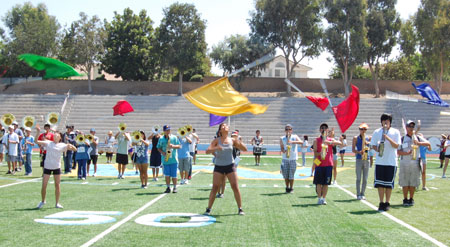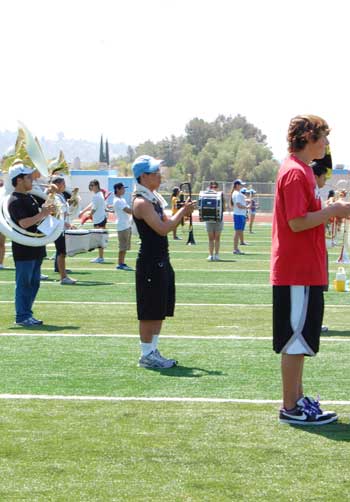Time for band camp

The color guard practiced with the band, adding their colorful flair. Photos by Kaitlyn Tsai, 16, Walnut HS
Monday morning in August, two weeks before school starts. First day of band camp. Open my eyes. Groan. Check the time. 7:40. Wonder how I slept through my 7:20 alarm. Get out of bed faster than Michael Phelps on Red Bull. Grab comfortable sneakers, water, sunscreen and, of course, a hat.
Twenty minutes and two gobbled breakfast rolls later, I walk into the band room. It’s this chaotic mess of music stands, chairs and friends catching up. I go around saying hi to everybody. I’m still a little grumpy from getting up so early but the sight of friends cheers me up. The chatter dies down as a student hands us our drill charts, which show us where to move for each count of the field show. Each page has a set of formations and choreographed moves that we have to perform. Before we even step on the field, my brain runs through just how long band camp really is. Play music. Correct horrible intonation. Teach freshmen. Memorize music. Learn drill. Memorize drill. Get way better at it. Compete. Win. The prospect of starting another show is as daunting as it is exciting.
Every summer for one or two weeks, 200 kids from my school (Walnut High) come together at band camp to learn a field show and rehearse and rehearse and rehearse. We have a reputation to uphold as one of the bigger and better bands in the state (we won third at state championships last year). At its best a field show is a work of art. Take a 200-piece marching band and have them play three or four difficult songs. Now have them do it while marching in different formations. The music, steps, instrument direction and placement all have to be synchronized. Add in a color guard that throws, twists and spins sabers and flags. Throw in performance theatricals such as poses or chants, and you have some idea of the difficulty of a field show.
Camp is only the first step in the process of rehearsing the field show. Rehearsing eats up Wednesdays after school and weekends during the fall competition season, which lasts until Thanksgiving. We wear blue military cadet-style uniforms that were modeled after West Point. Once we put on the uniform, it becomes show time. It seems kind of silly to spend so many hours for a 12-minute show. But on the field I feel transformed, like I’m part of something bigger.
9 a.m. After attendance, the band moves to the field to practice marching. We usually start with some basics to get the muscles moving. We have our own marching instructor who is different from our band director. He has us do crazy exercises, like group stretches, basic turns and slides (when your lower body marches in one direction while the upper body is turned in another). I realize that we’re a big band, and because of that our field shows look a lot cooler. With more people, we can perform more complex formations and take up more space on the field.
10:30 a.m. Next we work on the formations to the field show. For every measure of music, some part of the band is moving so that we’re almost never standing in the same spot for more than four beats. Done right, the formations look amazing, always forming a spiral, shape or diagonal.
Learning the field show can be tedious, because if even one marcher makes a single mistake or takes a step that’s not in sync, the whole band has to start over. When that happens we grumble a bit but go back to our spots. Better to mess up now and fix it than make a mistake in front of an audience.
Marching is a difficult process. Getting 200 people to raise and hit their feet on the ground at the same time is pretty complex. Toes have to be pointed up, and the step sizes have to be the same. But there is also the matter of showmanship. There’s a command called “Attention” where everyone holds their instrument and looks straight ahead. Sometimes my arms get sore after a day of doing this. But one move out of place could mean the difference between first and second at competitions.
Our most memorable practices are when we take our instruments on the field and go over the show for what feels like a million times. We play and march, and despite how easy this sounds, it is incredibly difficult. Usually we have the whole band spread out over the field and we go over each set. We memorize our places using our drill charts and the yard lines on the football field. We aren’t allowed to look at our feet because it’s considered bad showmanship. Another sign of sloppiness is the angle of the instrument. The trumpet has to be parallel to the ground. We are taught to look straight ahead and to use our peripheral vision to watch out for other people. We even have our own traffic laws. People marching backwards or sideways usually have the right of way, but sometimes accidents happen.
Noon Most of us are hot and tired from marching in the heat and are hungry for lunch. The lucky ones have their parents drop off KFC or McDonald’s, while others just eat sandwiches. I usually eat lunch with the trumpets. We talk about school or girls. Mostly girls though.
1 p.m. The band gets back together in the multi-purpose room to learn the music we’ll be marching to. This year the band’s doing selections from Mary Poppins.
3 p.m. Each section divides up to work on the music. This is usually my favorite part of the day because the trumpets get to bond together as a section. We’re always joking around. One running gag is that our trumpet section is the most racially diverse of all the sections, not in terms of human race, but because we have brass and silver trumpets, as well as my black trumpet. There is pressure to do well because the sound of a single trumpet off key or playing a wrong note can cut through the whole band. We rehearse for a couple hours then the band comes together to play the music. Everyone is put on the spot at one time or another. I get a dry throat when that happens, usually out of nervousness. It’s an instinctive reaction from my middle school days when I was last chair and the teacher scared me.
5 p.m. We go back to the football field to learn more drill. It’s tough concentrating at the end of the day, but it’s rewarding seeing how much we learned over the course of the day and eventually the week.
We’re usually dismissed around 6 or 7. After 11 hours of band camp, my arms are numb and I’m surprised they haven’t fallen off yet. I just want to go home and eat. There are times when I think I could be doing something else, but when I imagine the applause and the smiles that our show will bring to people’s faces, it brings a smile to my face too. I also do it to improve as a musician, and because it pushes the limits of my endurance.
Even though I go to sleep sore and tired, I feel as if I accomplished something that was bigger than myself and am proud of myself for having that level of dedication. The payoff doesn’t come until our first performance during the first football game. The crowd goes wild and cheers loudly, and the adrenaline mixes with a sense of accomplishment that we all did the show together. After a couple more football games it moves into competition season and from there championships. It makes me proud to say “Hey, I was part of that.”










1 Comment
Being a colorguard member, I enjoyed this article. What some people don’t understand about marching band is that it’s really demanding physically, mentally, and emotionally, and I’m glad there’s an article out there that gave people a glimpse at how being a band geek isn’t easy. I also saw the Walnut HS field show in 2009 at a band tournament, and I thought they were really cool.